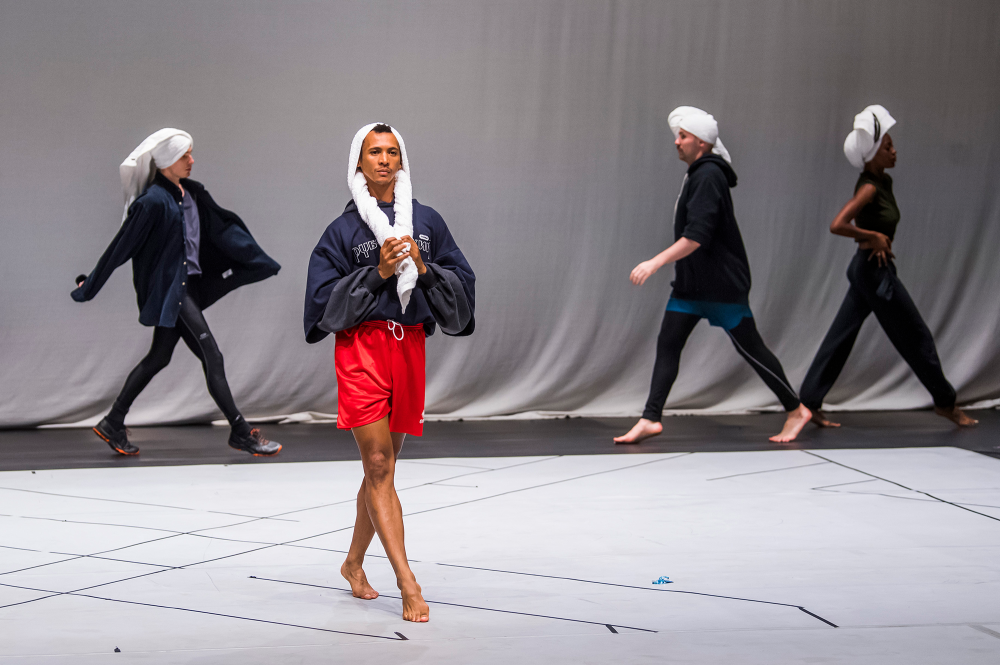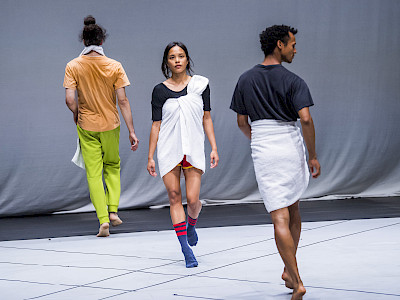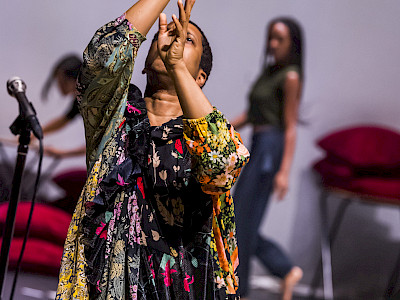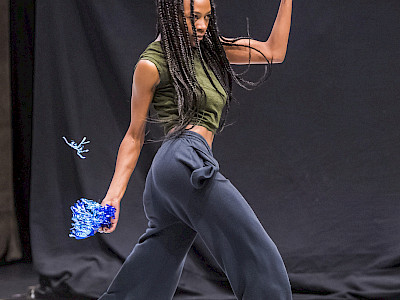24.05, 25.05.2023
Cat. Catwalk. Runway. This combination has been brewing in Trajal Harrell’s practice for twenty years through the evolution of his research on the history of runway movement, from the theatrical spectacles in the court of Louis XIV to its use in the contemporary dance tradition and in competitions. Harrell’s work exemplifies runway movement as a dance language of its own, and as a tool for character personification. In the case of Maggie the Cat, Maggie is both figurative and abstract. She is the troubled but tough central character of Tennessee Williams’ 1953-play Cat on a Hot Tin Roof. But Maggie is also an unstoppable energy, propelling the rhythm and structure of the performance forward. The dance is populated by the Mississippi milieu of the play: Big Mama, Big Daddy, and the African American servants on Big Daddy’s plantation. These characters build a rousing rhythm that guides the performance, danced with home furnishings, set to a soundtrack ranging from electro and pop to classical music, in an act that subverts the rules of the bourgeois house. After his highly acclaimed Bernarda Alba, presented at the festival last year, Harrell returns to Brussels with a bright choreography, where the hidden layers of a canonical classic explode with joy, intensity and freedom.
“Applause" doesn’t seem quite enough; it’s a thrilling work, both free and beautifully structured, profound and exhilarating - The Guardian
The straightforward ideas that animate “Maggie” – the catwalk procession, the exuberant self-expression, the transformation of ordinary household objects – are handled by Mr. Harrell with masterly timing and aesthetic flair - The New York Times
Maggie the Cat
Trajal Harrell takes on Tennessee Williams’ play Cat on a Hot Tin Roof. At the very least since the film adaption by Richard Brooks, it is a text that has entered into the collective white fantasy about the geohistorical phenomenon of the Southern States, perhaps only comparable to Gone with the Wind.
Trajal Harrell completely inverts the perspective on this material. The focus is no longer on the decadent end of a feudal era and its rich plantation owners, but on the black servants whose point of view Harrell assumes. This is the starting point of Maggie the Cat, which then moves on to leave its template as far behind as possible.
The servants are marginal figures in the play. Instead, Williams focuses on the white owners of a cotton plantation, and especially on the ‘cat’ Maggie and her husband Brick. It is, perhaps, precisely because it is missing the crucial perspective of African Americans, who are almost always present but barely speak, that Cat on a Hot Tin Roof is a play about the South.
Williams lets the South speak about love, fears and hatred – about resentment, jealousy and the tenderness of a privileged class, who naturally assumes that their lives deserve attention. However, it is only one half of this South that is permitted to speak in the play. In contrast to the invariably white protagonists, the African-American characters are given little dialogue and are used by Williams only for auxiliary tasks: they answer the phone, sing birthday songs, hand around items as needed. The very same group of people (and their ancestors) who produced Southern prosperity through cotton are so marginalised that their absence becomes an extremely present void. Harrell makes this the focus of Maggie the Cat.
In Maggie the Cat’s narrative, the performers are ser-vants who move through a space that is not theirs. Just like Williams’ work, Harrell’s evening is a chamber play in which the living space of the wealthy, with its trinkets, objects and fetishes, is no longer inhabited by the proprietors but by those who usually only set it up, keeping it clean and tidy. They have no right of residence in it. In Maggie the Cat, they appropriate and play with the everyday objects they find – towels, aprons, pillows, sheets – and invent unexpected usages for them. They turn the living room into an interior of light-spirited self-empowerment and redefine its use for themselves.
It is a woman that opens the door to these new usages. To be precise, it is the imaginary figure of a woman: a woman who moves across this space freely and with pride, but is nonetheless an outsider. In Williams’ play, the eponymous Maggie is from a poor background. Even more than through their shared experience of economic scarcity, it is Maggie’s temperament and her understanding of relationships that create a connection between herself and the servants. Maggie ventured into this space with her explosive femininity, her reckless desire and her intelligence – and because she has come into this space before them, the servants need no longer dread it.
On the one hand, the servants mimic Maggie as an obviously affluent woman who herself has had to learn her role. She has never lost the consciousness that even wealth is just a role, coincidental and replaceable by other roles.
On the other hand, this cultural appropriation from below is not just a matter of class but also of race.
To give an example of the superimposed layers of perception that filter through the evening, one could pick out the moment when the performers on stage transform a racist white practice into an aesthetic strategy. The act of brownfeeting in Maggie the Cat is not even an allusion to blackfacing but a new, delicate gesture, one that could hardly be more radical and leaves its traces not just on the ground. In Maggie the Cat, this is just a brief moment. It is not white performers who smear black paint onto their faces in order to racially discredit Black people, but a diverse cast who gently dip their feet into different shades of brown in order to carefully tiptoe across the floor and leave little dabs of colour. It is a moment of silence, of waiting; unspectacular. It happens as if by the way – and not least because of this lightness, it has almost revolutionary potential.
Perhaps it is Harrell’s sense of humour that, again and again, transforms his aesthetic deconstructions into playful, undogmatic offers. He uses the stage and its potential for transformation to convert playful claims into political food for thought. But all the while, these suggestions remain casual, aesthetic, quiet. Until Maggie finally slips in. Into the little black dress of the affluent, white woman.
- Katinka Deecke
Presentation: Kunstenfestivaldesarts, KVS
Direction, choreography, costume design and sound design: Trajal Harrell | Set design: Erik Flatmo, Trajal Harrell | Lighting design: Stéfane Perraud | Director’s assistant: Lennart Boyd Schürmann | Dramaturgy: Katinka Deecke | Performers: Trajal Harrell, Stephanie Amurao, Helan Boyd Auerbach, Vânia Doutel Vaz, Rob Fordeyn, Christopher Matthews, Nasheeka Nedsreal, Perle Palombe, Songhay Toldon, Ondrej Vidlar, Tiran Normanson | Touring: Causecélèbre, the European touring company of Trajal Harrell who is currently an artist in residence at Schauspielhaus Zürich | Causecélèbre: is based in Belgium and is administrated by Lena Appel in collaboration with Lies Martens | Diffusion: ART HAPPENS
Production: Manchester International Festival
Maggie the Cat forms one part of a trilogy, Porca Miseria, commissioned by Manchester International Festival, Schauspielhaus Zürich, ONASSIS STEGI, Kampnagel, Holland Festival, the Barbican and Dance Umbrella, NYU Skirball, Berliner Festspiele and The Arts Centre at NYU Abu Dhabi





